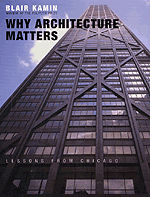Why Blair Kamin Matters

In a recent essay in the journal Places (part of the Design Observer group), Nancy Levinson argues against the recent trend of globe-trotting architecture criticism and proposes instead a return to local expertise. Of the current criticism, she writes:
“You’ve got the editorial charge to be national and international, like the rest of the paper, and you’ve got the budget to roam. So you rack up the datelines: Los Angeles, Miami, Boston, Moscow, Stuttgart, Basel, etc. etc. But the view from the tower is broad not sharp, panoramic but not particular. The inevitable result is that you are writing at the thin edge of scant knowledge: you are critiquing places you know only as a tourist, and buildings you know only from brief and usually tightly programmed visits, often in the company of the watchful designer. This is no way to gain meaningful experience or serious knowledge of a building or landscape or how it fits within its local setting and larger environs.
But of the future of criticism, she singles out several critics (including Michael Sorkin, whose Twenty Minutes in Manhattan we distribute for Reaktion Books) who are “[making the commitment to] somehow… deglamorize the global, to make it a measure of critical strength to commit to the local.” And she reserves great praise, especially on this count, for the Chicago Tribune‘s Blair Kamin and his Why Architecture Matters: Lessons from Chicago.
In the book, Kamin’s subjects range from high-rises to highways, parks to public housing, Frank Lloyd Wright to Frank Gehry. First published in 2001, Why Architecture Matters collects the best of Kamin’s acclaimed columns, offering both a look at America’s foremost architectural city and a taste of Kamin’s penetrating, witty style of critique.
This fall, Kamin will publish another book with the Press. Due in October, Terror and Wonder tells the story of a tumultuous decade in American architectural history. The more than fifty pieces included in the book cover the period stretching from the terrorist attacks of 9/11 through the onset of the Great Recession, the inauguration of would-be architect Barack Obama, and the completion of the last major projects of the decade-long building boom. In all, Kamin’s book captures an era marked, paradoxically, by abiding fear, giddy excess, and growing concern for the environment, all of which were reflected in the buildings and public spaces designed and constructed during these years.
Check back here for more information on the forthcoming Terror and Wonder.